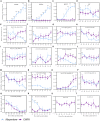Genome-Wide Analysis of CCT Transcript Factors to Identify Genes Contributing to Photoperiodic Flowering in Oryza rufipogon
- PMID: 34819938
- PMCID: PMC8606741
- DOI: 10.3389/fpls.2021.736419
Genome-Wide Analysis of CCT Transcript Factors to Identify Genes Contributing to Photoperiodic Flowering in Oryza rufipogon
Abstract
Photoperiod sensitivity is a dominant determinant for the phase transition in cereal crops. CCT (CONSTANS, CO-like, and TOC1) transcription factors (TFs) are involved in many physiological functions including the regulation of the photoperiodic flowering. However, the functional roles of CCT TFs have not been elucidated in the wild progenitors of crops. In this study, we identified 41 CCT TFs, including 19 CMF, 17 COL, and five PRR TFs in Oryza rufipogon, the presumed wild ancestor of Asian cultivated rice. There are thirty-eight orthologous CCT genes in Oryza sativa, of which ten pairs of duplicated CCT TFs are shared with O. rufipogon. We investigated daily expression patterns, showing that 36 OrCCT genes exhibited circadian rhythmic expression. A total of thirteen OrCCT genes were identified as putative flowering suppressors in O. rufipogon based on rhythmic and developmental expression patterns and transgenic phenotypes. We propose that OrCCT08, OrCCT24, and OrCCT26 are the strong functional alleles of rice DTH2, Ghd7, and OsPRR37, respectively. The SD treatment at 80 DAG stimulated flowering of the LD-grown O. rufipogon plants. Our results further showed that the nine OrCCT genes were significantly downregulated under the treatment. Our findings would provide valuable information for the construction of photoperiodic flowering regulatory network and functional characterization of the CCT TFs in both O. rufipogon and O. sativa.
Keywords: CCT genes; Oryza rufipogon; expression profiles; genomic synteny; photoperiodic flowering regulation; rice.
Copyright © 2021 Peng, Tun, Dai, Li, Zhang, Yin, Yoon, Cho, An and Gao.
Conflict of interest statement
The authors declare that the research was conducted in the absence of any commercial or financial relationships that could be construed as a potential conflict of interest.
Figures









Similar articles
-
Combined analysis and miRNA expression profiles of the flowering related genes in common wild rice (oryza rufipogon Griff.).Genes Genomics. 2018 Aug;40(8):835-845. doi: 10.1007/s13258-018-0688-y. Epub 2018 Apr 21. Genes Genomics. 2018. PMID: 30047109 Free PMC article.
-
The rice CONSTANS-like protein OsCOL15 suppresses flowering by promoting Ghd7 and repressing RID1.Biochem Biophys Res Commun. 2018 Jan 1;495(1):1349-1355. doi: 10.1016/j.bbrc.2017.11.095. Epub 2017 Nov 16. Biochem Biophys Res Commun. 2018. PMID: 29154991
-
Ehd3, encoding a plant homeodomain finger-containing protein, is a critical promoter of rice flowering.Plant J. 2011 May;66(4):603-12. doi: 10.1111/j.1365-313X.2011.04517.x. Epub 2011 Mar 9. Plant J. 2011. PMID: 21284756
-
Switching genetic effects of the flowering time gene Hd1 in LD conditions by Ghd7 and OsPRR37 in rice.Breed Sci. 2019 Mar;69(1):127-132. doi: 10.1270/jsbbs.18060. Epub 2019 Feb 27. Breed Sci. 2019. PMID: 31086490 Free PMC article.
-
CCT domain-containing genes in cereal crops: flowering time and beyond.Theor Appl Genet. 2020 May;133(5):1385-1396. doi: 10.1007/s00122-020-03554-8. Epub 2020 Jan 31. Theor Appl Genet. 2020. PMID: 32006055
Cited by
-
Sucrose preferentially promotes expression of OsWRKY7 and OsPR10a to enhance defense response to blast fungus in rice.Front Plant Sci. 2023 Jan 27;14:1117023. doi: 10.3389/fpls.2023.1117023. eCollection 2023. Front Plant Sci. 2023. PMID: 36778713 Free PMC article.
-
Genome-Wide Identification of BrCMF Genes in Brassica rapa and Their Expression Analysis under Abiotic Stresses.Plants (Basel). 2024 Apr 17;13(8):1118. doi: 10.3390/plants13081118. Plants (Basel). 2024. PMID: 38674527 Free PMC article.
-
The grain yield regulator NOG1 plays a dual role in latitudinal adaptation and cold tolerance during rice domestication.Front Genet. 2022 Nov 11;13:1039677. doi: 10.3389/fgene.2022.1039677. eCollection 2022. Front Genet. 2022. PMID: 36437935 Free PMC article.
-
A VIN3-like Protein OsVIL1 Is Involved in Grain Yield and Biomass in Rice.Plants (Basel). 2021 Dec 28;11(1):83. doi: 10.3390/plants11010083. Plants (Basel). 2021. PMID: 35009085 Free PMC article.
-
Ancient Duplication and Lineage-Specific Transposition Determine Evolutionary Trajectory of ERF Subfamily across Angiosperms.Int J Mol Sci. 2024 Apr 1;25(7):3941. doi: 10.3390/ijms25073941. Int J Mol Sci. 2024. PMID: 38612750 Free PMC article.
References
-
- An G., Ebert P. R., Mitra A., Ha S. B. (1989). “Binary vectors,” in Plant Molecular Biology Manual, ed. Kluwer Academic Publisher (Dordrecht: Springer; ), 29–47.
LinkOut - more resources
Full Text Sources
Research Materials

